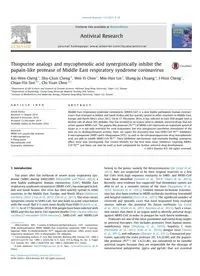
2015 Thiopurine analogs and mycophenolic acid synergistically inhibit the papain-like protease of Middle East respirator PDF
Preview 2015 Thiopurine analogs and mycophenolic acid synergistically inhibit the papain-like protease of Middle East respirator
Thiopurine analogs and mycophenolic acid synergistically inhibit the papain-like protease of Middle East respiratory syndrome coronavirus Kai-Wen Cheng a, Shu-Chun Cheng b, Wei-Yi Chen c, Min-Han Lin a, Shang-Ju Chuang a, I-Hsin Cheng c, Chiao-Yin Sun b,⇑, Chi-Yuan Chou a,⇑ a Department of Life Sciences and Institute of Genome Sciences, National Yang-Ming University, Taipei 112, Taiwan b Department of Nephrology, Chang-Gung Memorial Hospital, Keelung 204, Taiwan c Institute of Biochemistry and Molecular Biology, National Yang-Ming University, Taipei 112, Taiwan a r t i c l e i n f o Article history: Received 13 August 2014 Revised 8 December 2014 Accepted 12 December 2014 Available online 24 December 2014 Keywords: MERS-CoV papain-like protease 6-Mercaptopurine 6-Thioguanine Mycophenolic acid Synergistic inhibition a b s t r a c t Middle East respiratory syndrome coronavirus (MERS-CoV) is a new highly pathogenic human coronav- iruses that emerged in Jeddah and Saudi Arabia and has quickly spread to other countries in Middle East, Europe and North Africa since 2012. Up to 17 December 2014, it has infected at least 938 people with a fatality rate of about 36% globally. This has resulted in an urgent need to identify antiviral drugs that are active against MERS-CoV. The papain-like protease (PLpro) of MERS-CoV represents an important antiviral target as it is not only essential for viral maturation, but also antagonizes interferon stimulation of the host via its deubiquitination activity. Here, we report the discovery that two SARS-CoV PLpro inhibitors, 6-mercaptopurine (6MP) and 6-thioguanine (6TG), as well as the immunosuppressive drug mycophenolic acid, are able to inhibit MERS-CoV PLpro. Their inhibition mechanisms and mutually binding synergistic effect were also investigated. Our results identify for the first time three inhibitors targeting MERS- CoV PLpro and these can now be used as lead compounds for further antiviral drug development. � 2014 Elsevier B.V. All rights reserved. 1. Introduction Ten years after the outbreak of severe acute respiratory syn- drome (SARS) during 2002/2003 (Hilgenfeld and Peiris, 2013), a new highly pathogenic human coronavirus (CoV), Middle East respiratory syndrome coronavirus (MERS-CoV), has emerged in Jed- dah and Saudi Arabia; this virus has then quickly spread to other countries in the Middle East, Europe, and North Africa (Anderson and Baric, 2012; Chan et al., 2012; Zaki et al., 2012). The virus causes symptoms similar to SARS-CoV, but also leads to acute renal failure with the result that it is even more deadly than SARS (Eckerle et al., 2013). As of 17 December 2014, 938 people have been infected with MERS and this has led to 343 reported deaths (http://www.who.int/ csr/don/17-december-2014-mers/en/). SARS-CoV and MERS-CoV belong to the genus, namely the Betacoronavirus (de Groot et al., 2013). Bats are suspected to be their original reservoir as a few bat CoVs with high sequence similarity to SARS- and MERS-CoV have been identified (Drexler et al., 2014; Ithete et al., 2013). Recently, new evidence has suggested that dromedary camels are able to act as a zoonotic source of the virus (Haagmans et al., 2014; Reusken et al., 2013). Limited human-to-human transmis- sion has also been evident in MERS outbreaks involving household and hospital contacts (Assiri et al., 2013). The significant number of clustered and sporadic cases that have originated from multiple sources indicate the potential for future outbreaks (de Groot et al., 2013; Ithete et al., 2013; Reusken et al., 2013). Such a situa- tion means that there is an urgent need to identify antiviral drugs against MERS-CoV in order to prepare for such future outbreaks. Proteases are one of the most prominent and useful drug targets in antiviral therapies; this includes proteases from human immu- nodeficiency virus (Wensing et al., 2010), hepatitis C virus (Hulskotte et al., 2012; Kwo et al., 2010), dengue virus (Steuer et al., 2011), and influenza (Zhirnov et al., 2011). Coronaviral pro- teases, specially the main protease (EC 3.4.22.69) and the papain- like protease (PLpro) (EC 3.4.22.46), are considered to be suitable antiviral targets because they are responsible for the cleavage of nonstructural polyproteins (pp1a and pp1ab) that are essential http://dx.doi.org/10.1016/j.antiviral.2014.12.011 0166-3542/� 2014 Elsevier B.V. All rights reserved. Abbreviations: AFC, 7-amino-4-trifluoro-methylcoumarin; CoV, coronavirus; DUB, deubiquitination; MERS, Middle East respiratory syndrome; 6MP, 6-mercap- topurine; NEM, N-ethylmaleimide; PLpro, papain-like protease; SARS, severe acute respiratory syndrome; 6TG, 6-thioguanine; Ub, ubiquitin. ⇑ Corresponding authors at: 222, Mai-Chin Rd., Keelung 204, Taiwan. Tel.: +886 2 24313131x3170; fax: +886 2 24335342 (C.Y. Sun). 155 Li-Nong St., Sec. 2, Taipei 112, Taiwan. Tel.: +886 2 28267168; fax: +886 2 28202449 (C.Y. Chou). E-mail addresses:
